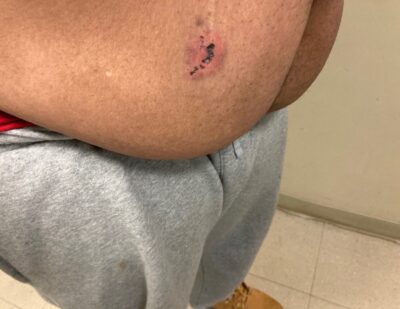0In dog bite litigation, occasionally there is uncertainty about whether the injury inflicted to a person resulted from a dog bite vs dog scratch.

From a legal perspective, a person sustains a dog bite injury when the teeth of a dog puncture or tear the skin of a person or possibly the person’s clothing. Injuries range from minor to severe and include lacerations, puncture wounds, and avulsions (tearing off layers of the skin from the body). In contrast, a scratch happens when the dog’s nails scrape a person’s skin, usually resulting in a superficial or deep linear-like wounds.
Previously, I mentioned criteria to differentiate a dog bite from a dog scratch. Below I expound upon my thoughts on this issue after receiving an email inquiry from a dog owner.
The dog owner wrote that his 13-year-old goldendoodle allegedly bit a FedEx driver on the stomach. However, the dog owner, probably concerned about being sued, did not believe that his dog could act in this manner given that his dog had never jumped on or bit anyone previously. In addition, the owner questioned if his dog was capable of inflicting a bite injury with only half of its mouth: that is, just by using its upper teeth. A photograph of the injury to the stomach of the FedEx driver shows a bite wound caused only by the upper teeth and not both the upper and lower teeth (i.e. contralateral wound).
Examination of the injury show the typical characteristics of the dog bite injury (circular, jagged edges) but with no contralateral wounds (i.e., a pattern where both the upper and lower teeth all the dog close simultaneously on the the skin of the victim causing wounds on the opposite side of each other) [1]Visit another section of this website for the additional illustration. Hence, the owner of the Goldendoodle questioned how his dog could bite a person with only “half of its mouth.”
In my experience, a dog bite injury does not always result in contralateral wounds. Yes, this can happen, under certain circumstances, particularly when the face of the person is bitten.
Whether a contralateral wound is inflicted may depend on the positioning of the victim and the dog at the time of the bite and the area of the victim’s body that was bitten. In addition, the dog’s size relative to the victim’s size may be a factor.
In the current instance, I speculate that the large fold on the stomach of this victim may have blocked the dog’s lower teeth from making contact with the stomach, or his large stomach prevented capturing an image of the bite injury underneath the fold.
The reader should also visit California criteria required for more information about dog bite identification.
________
Richard Polsky, Ph.D. is a dog bite expert in Los Angeles. Dr. Polsky has testified as an expert witness on many cases about dog bite identification. Attorneys can connect with Dr. Polsky through the Attorney Contact Form.
Footnotes
| ↑1 | Visit another section of this website for the additional illustration |
|---|
